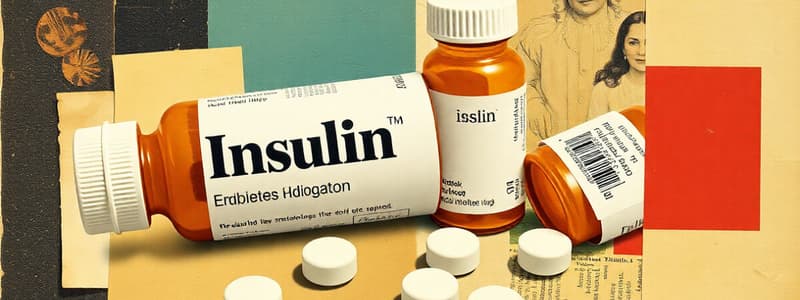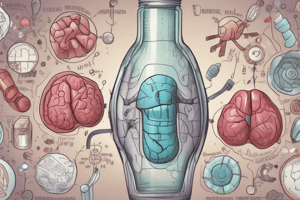Podcast
Questions and Answers
Which of the following insulin types would be LEAST appropriate for immediate post-meal glucose control due to its delayed onset of action?
Which of the following insulin types would be LEAST appropriate for immediate post-meal glucose control due to its delayed onset of action?
- Insulin aspart
- Insulin lispro
- NPH insulin (correct)
- Regular insulin
A patient with type 1 diabetes is prescribed insulin glargine. The nurse is educating the patient on the medication. Which statement by the patient indicates a NEED for further teaching?
A patient with type 1 diabetes is prescribed insulin glargine. The nurse is educating the patient on the medication. Which statement by the patient indicates a NEED for further teaching?
- I should not mix this insulin with other insulins in the same syringe.
- This insulin will provide a steady level of insulin coverage for about 24 hours.
- I should take this insulin at the same time each day.
- This insulin will have a peak effect in about 1 to 2 hours. (correct)
A patient receiving NPH insulin twice daily consistently experiences hypoglycemia in the mid-afternoon. Which change to the insulin regimen would MOST effectively address this issue?
A patient receiving NPH insulin twice daily consistently experiences hypoglycemia in the mid-afternoon. Which change to the insulin regimen would MOST effectively address this issue?
- Switching to insulin glargine once daily
- Decreasing the evening NPH dose
- Administering the morning NPH dose at breakfast and adding a rapid-acting insulin injection at lunch
- Dividing the morning NPH dose into two smaller doses, given before breakfast and at lunch (correct)
A patient with type 2 diabetes is prescribed both metformin and insulin. What physiological process is MOST directly addressed through the combined use of these medications?
A patient with type 2 diabetes is prescribed both metformin and insulin. What physiological process is MOST directly addressed through the combined use of these medications?
A pregnant patient is diagnosed with gestational diabetes (GDM) and is unable to control her blood glucose levels with diet and exercise alone. Considering the information provided, which insulin regimen would be the MOST appropriate INITIAL approach?
A pregnant patient is diagnosed with gestational diabetes (GDM) and is unable to control her blood glucose levels with diet and exercise alone. Considering the information provided, which insulin regimen would be the MOST appropriate INITIAL approach?
A patient with type 1 diabetes is admitted to the hospital with diabetic ketoacidosis (DKA). Besides intravenous fluids, which type of insulin is MOST appropriate to administer initially?
A patient with type 1 diabetes is admitted to the hospital with diabetic ketoacidosis (DKA). Besides intravenous fluids, which type of insulin is MOST appropriate to administer initially?
A nursing home resident with type 2 diabetes is prescribed NPH insulin BID. The nurse observes that the patient often skips meals due to poor appetite. What is the MOST appropriate nursing intervention related to the insulin administration?
A nursing home resident with type 2 diabetes is prescribed NPH insulin BID. The nurse observes that the patient often skips meals due to poor appetite. What is the MOST appropriate nursing intervention related to the insulin administration?
A patient with diabetes is being discharged. Which of the following patient statements indicates a GOOD understanding of foot care instructions?
A patient with diabetes is being discharged. Which of the following patient statements indicates a GOOD understanding of foot care instructions?
A patient with type 2 diabetes who takes oral medications develops a severe foot ulcer. The provider prescribes IV antibiotics and admits the patient to the hospital. What ADDITIONAL intervention is MOST important to consider for this patient during their hospital stay?
A patient with type 2 diabetes who takes oral medications develops a severe foot ulcer. The provider prescribes IV antibiotics and admits the patient to the hospital. What ADDITIONAL intervention is MOST important to consider for this patient during their hospital stay?
A patient prescribed insulin reports difficulty drawing up two types of insulin (NPH and regular) into the same syringe. What is the MOST appropriate instruction for the nurse to provide?
A patient prescribed insulin reports difficulty drawing up two types of insulin (NPH and regular) into the same syringe. What is the MOST appropriate instruction for the nurse to provide?
Which complication is MOST directly related to chronic hyperglycemia in diabetes?
Which complication is MOST directly related to chronic hyperglycemia in diabetes?
A patient with type 1 diabetes is preparing for a vigorous workout. Which adjustment to their insulin regimen is MOST appropriate to prevent hypoglycemia?
A patient with type 1 diabetes is preparing for a vigorous workout. Which adjustment to their insulin regimen is MOST appropriate to prevent hypoglycemia?
A patient with diabetes is diagnosed with gastroparesis. What dietary modification is MOST important for the nurse to teach?
A patient with diabetes is diagnosed with gastroparesis. What dietary modification is MOST important for the nurse to teach?
A patient with diabetes is prescribed a medication that impairs their ability to sense hypoglycemia. Which medication has this side effect?
A patient with diabetes is prescribed a medication that impairs their ability to sense hypoglycemia. Which medication has this side effect?
A patient who has just been diagnosed with type 2 diabetes asks about the role of family history. Which explanation is MOST accurate?
A patient who has just been diagnosed with type 2 diabetes asks about the role of family history. Which explanation is MOST accurate?
Which of the following is the MOST critical step in managing sick days for a patient with diabetes?
Which of the following is the MOST critical step in managing sick days for a patient with diabetes?
A patient with diabetes is prescribed pramlintide in addition to insulin. Which of the following teaching points is MOST IMPORTANT for the nurse to emphasize?
A patient with diabetes is prescribed pramlintide in addition to insulin. Which of the following teaching points is MOST IMPORTANT for the nurse to emphasize?
A patient with diabetic nephropathy is prescribed an ACE inhibitor. What is the PRIMARY reason for using this medication in this patient population?
A patient with diabetic nephropathy is prescribed an ACE inhibitor. What is the PRIMARY reason for using this medication in this patient population?
A patient with a history of cardiovascular disease and diabetes is prescribed pioglitazone. What potential risk associated with this medication should the nurse closely monitor for?
A patient with a history of cardiovascular disease and diabetes is prescribed pioglitazone. What potential risk associated with this medication should the nurse closely monitor for?
A patient with diabetes is found unresponsive and hypoglycemic. After administering glucagon, the nurse should prioritize which of the following actions?
A patient with diabetes is found unresponsive and hypoglycemic. After administering glucagon, the nurse should prioritize which of the following actions?
Flashcards
Rapid-Acting Insulin
Rapid-Acting Insulin
Insulin that starts working very quickly. Examples include insulin lispro (Humalog), insulin aspart (NovoLog), and insulin glulisine (Apidra).
Short-Acting Insulin
Short-Acting Insulin
Insulin with a slightly slower onset. An example is regular insulin (Humulin R, Novolin R).
Intermediate-Acting Insulin
Intermediate-Acting Insulin
Insulin that has a longer duration of action. An example is NPH insulin (Humulin N, Novolin N).
Long-Acting Insulin
Long-Acting Insulin
Signup and view all the flashcards
Type 1 Diabetes (T1DM)
Type 1 Diabetes (T1DM)
Signup and view all the flashcards
Type 2 Diabetes (T2DM)
Type 2 Diabetes (T2DM)
Signup and view all the flashcards
Gestational Diabetes (GDM)
Gestational Diabetes (GDM)
Signup and view all the flashcards
Diabetes Assessment
Diabetes Assessment
Signup and view all the flashcards
Diabetes Medications Education
Diabetes Medications Education
Signup and view all the flashcards
Diabetes Exercise Recommendations
Diabetes Exercise Recommendations
Signup and view all the flashcards
Hypoglycemia Treatment
Hypoglycemia Treatment
Signup and view all the flashcards
DKA/HHS Nursing Interventions
DKA/HHS Nursing Interventions
Signup and view all the flashcards
Diabetes Education Topics
Diabetes Education Topics
Signup and view all the flashcards
Important components of diabetes patient teaching.
Important components of diabetes patient teaching.
Signup and view all the flashcards
Major Complications of Diabetes
Major Complications of Diabetes
Signup and view all the flashcards
Study Notes
Types of Insulin
- Rapid-acting insulin examples include Insulin lispro (Humalog), Insulin aspart (NovoLog), and Insulin glulisine (Apidra)
- Onset is 10-15 minutes, peaks in 1-2 hours, and lasts 3-5 hours
- Administer before meals and monitor for hypoglycemia
- Short-acting insulin example is Regular insulin (Humulin R, Novolin R)
- Onset is 30-60 minutes, peaks in 2-4 hours, and lasts 5-8 hours
- Administer intravenously or subcutaneously 30 minutes before meals
- Intermediate-acting insulin example is NPH insulin (Humulin N, Novolin N)
- Onset is 1-2 hours, peaks in 4-12 hours, and lasts 12-18 hours
- This insulin is cloudy and needs to be rolled to mix, and is often taken twice daily (BID)
- Long-acting insulin examples include Insulin glargine (Lantus) and Insulin detemir (Levemir)
- Onset is 1-2 hours, has a minimal peak, and lasts approximately 24 hours
- Do not mix it and administer at the same time daily
Types of Diabetes
- Type 1 Diabetes (T1DM) is caused by autoimmune beta-cell destruction
- Treatment involves lifelong insulin, carbohydrate counting, and blood glucose monitoring
- Type 2 Diabetes (T2DM) is caused by insulin resistance and beta-cell dysfunction
- Risk factors include obesity, sedentary lifestyle, and family history
- Treatment involves lifestyle changes, oral medications, and insulin as needed
- Gestational Diabetes (GDM) is caused by hormonal insulin resistance during pregnancy
- Treatment involves diet, exercise, and insulin if needed
- Other specific types of diabetes include MODY, LADA, and secondary causes such as steroids and pancreatitis
Nursing Care for Diabetes
- Assessment involves monitoring blood glucose, assessing symptoms, and reviewing adherence to treatment
- Nursing interventions include teaching about medications and their side effects, nutrition through carb counting and a balanced diet, and encouraging exercise while monitoring blood glucose
- Treat hypoglycemia with 15g of carbohydrates and recheck in 15 minutes
- For DKA/HHS, monitor hydration and administer insulin/fluids
- Education: Provide education on monitoring, sick day rules, and foot care
- Patient teaching should include daily foot inspection, sick day insulin use, and warning signs
- Complications of diabetes can include eye, kidney, nerve, and cardiovascular diseases
Studying That Suits You
Use AI to generate personalized quizzes and flashcards to suit your learning preferences.




